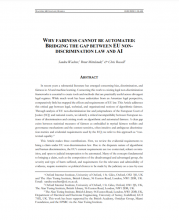
United Kingdom
In recent years a substantial literature has emerged concerning bias, discrimination, and fairness in AI and machine learning. Connecting this work to existing legal non-discrimination frameworks is essential to create tools and methods that are practically useful across divergent legal regimes. While much work has been undertaken from an American legal perspective, comparatively little has mapped the effects and requirements of EU law. This Article addresses this critical gap between legal, technical, and organisational notions of algorithmic fairness. Through analysis of EU non-discrimination law and jurisprudence of the European Court of Justice (ECJ) and national courts, we identify a critical incompatibility between European notions of discrimination and existing work on algorithmic and automated fairness. A clear gap exists between statistical measures of fairness as embedded in myriad fairness toolkits and governance mechanisms and the context-sensitive, often intuitive and ambiguous discrimination metrics and evidential requirements used by the ECJ; we refer to this approach as “contextual equality.”